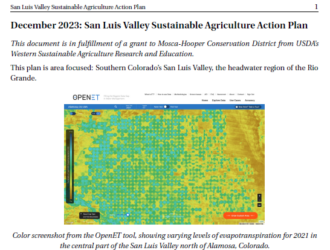This plan is area focused: Southern Colorado’s San Luis Valley, the headwater region of the Rio
Grande.
Irrigation in this high, arid valley is from a combination of surface water from the Rio Grande
and its tributaries, and pumping from confined and unconfined aquifers. Because these water
resources are overdrafted and connected, managing for sustainability of agriculture involves the
whole valley. In addition, water issues are connected to issues of community, economy, and
power, as well as attitudes and beliefs that in some cases have been hardened by scarcity and
conflict.
Because of these connections, our process of compiling stakeholder concerns and needs was
deliberate and sometimes slow, as described in the Methods section beginning on page 3. The
sustainability of agriculture in the San Luis Valley involves more than irrigation efficiency. For
most participants in this process, sustainability involves transformational or attitudinal change
in beliefs and behaviors, combined with an open-minded, peer-to-peer,
This material is based upon work that is supported by the National Institute of Food and Agriculture, U.S. Department of Agriculture through the Sustainable Agriculture Research and Education (SARE) program. Any opinions, findings, conclusions, or recommendations expressed in this publication are those of the author(s) and should not be construed to represent any official USDA or U.S. Government determination or policy.
